Examples of the Solitaire Games of Skill collection giving the player information so that he has to scan the layout less
are described below.
-
When you can see all possible moves at a glance
Cards in all rows that can change position are marked with blue strips as seen in the screen shot below of Yukon. Dark blue strips generally mean the card can be built on the tableau while light blue strips mean the card can go on a foundation. Thus the need for tediously scanning the layout is removed allowing the player to focus more on strategy. -
When you can see all cards that when built upon will uncover a face down card or create a space
Cards which can be used to make a space are or uncover a face down card are crucial for many games including Yukon, Alaska, Spider, and FreeCell. If not on the top of a tableau column, cards which can make a space or uncover a face down card are marked with an orange strip. In the Yukon screen shot below, the four of spades in column two is marked with orange. It can be used to pick up the three of hearts in column six. Using this feature win rates for the game Alaska can increase from 10% to 50%.
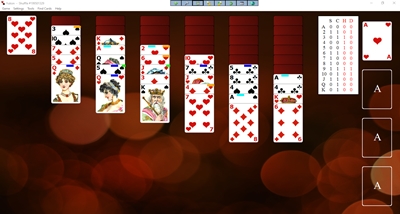
-
When you can find any card instantly
Suppose in the Yukon screenshot, you want to find a red six to move the black five off of the four marked with orange in column two. The red six in column three is marked using the appropriate menu with a yellow strip as seen above. -
When you are notified if all the ranks of a suit are available
In the Spider screen shot below the D on the last row of the table indicates that an entire suit of diamonds is available for possible removal.
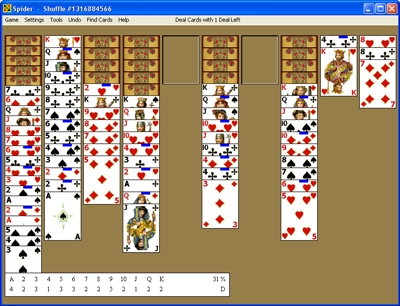
-
When potential blocks in the tableau are shown
-
When playing Golf the game may be lost if certain cards on the wastepile are not built upon by the right card.
In the Golf screen shot below, all the queens are marked with orange strips. The orange strip means
that the number of cards or card sequences that can be used to place an orange card of a given rank
on the wastepile is equal to the number of orange cards of that given rank. If one more card or card sequence is
lost that can be used for building a card with an orange strip on the wastepile, the game is lost.
For example there are three queens in the tableau and one jack in the tableau and two jacks waiting
to be dealt. If one of these three jacks is used to move a ten to the wastepile and not a queen, the game is
lost. There will not be enough jacks to remove the three queens to the wastepile.
The player is notified whenever the game is lost and the card rank involved is indicated.
Otherwise the casual player could continue to play the game long after the game was lost.

-
Under tradional rules, tableau cards cannot fill a space when playing Mount Olympus. Thus Mount Olympus can be lost
if a card in the tableau covers a card that could be used to build the covering card on a foundation. Such covering cards
are marked with an orange strip. For example, in the screen shot below the seven of clubs in column eight covers a five of clubs. If the
five of clubs in column five is used to build the seven of clubs in column five on a foundation the game is lost.
The five of clubs in column eight becomes inaccessible since it is the only card which can move the seven of clubs above it.
Under normal conditions Mount Olympus using traditional rules has a win rate of about 50%. With orange strips to guide the player, win rates of nearly 80% are possible.
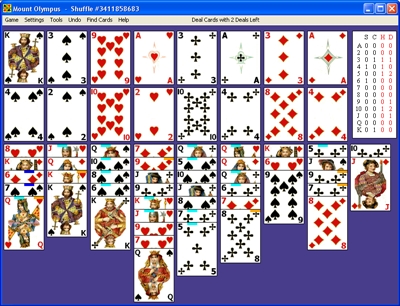
-
The game Vertical is a version of the game Nestor. It has almost the same rules which include that cards can be removed
in pairs if they have the same rank. The object of the game is to remove all the cards from the tableau.
In the screen shot at the right, there is only one pair of cards with rank seven left. These two cards are in
columns two and five. The seven in column two covers a six while the seven in column five is covered by a six.
There are also cards of rank six in columns one and three. If the sixes in columns one and three are paired and
removed, the game is lost. This is because as a result of pairing these sixes, the sixes and sevens in columns two and five
can never be paired and removed since a six needed to uncover a seven is itself covered by a seven.
To indicate the potential danger the sevens are marked with an orange strip while the sixes are marked with
dark blue strips.
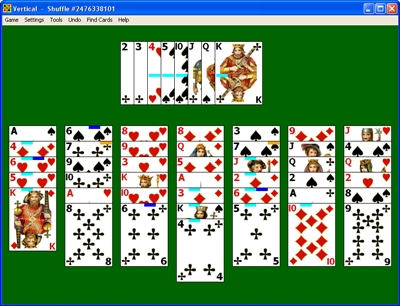
-
The kings are not automatically moved to the bottom of their columns for the version of Baker's Dozen discussed here.
The kings are only moved below cards which would make winning impossible if the king stayed above the card.
The Baker's Dozen screenshot below shows a table in the lower right corner. The first column of the table lists the all the card ranks except ace.
The second column gives the number of cards of the indicated rank which are not covered by cards of the next lowest rank.
For example the number zero next to the jack rank indicates that every jack is covered by a card of rank 10. This means
that none of the jacks can be moved unless one of the tens is sent to a foundation. Therefore the cards underneath the
jack in column 5 of the tableau are inaccessible. Notice that for rank five in the table the number of cards not covered by a
card of the next lowest rank is in red. This results from the king in column 13 covering a rank six card.
With the king covering a six there are not enough cards of rank six to move all the cards of rank five.
Therefore the player must chose which rank five card he can afford not to move.
Columns which have two or more cards of the same rank are potential trouble spots since both cards could be easily trapped as discussed above.
These columns are marked with a yellow asterisk as are columns 1, 4, 6, 7, and 8 in the screenshot.
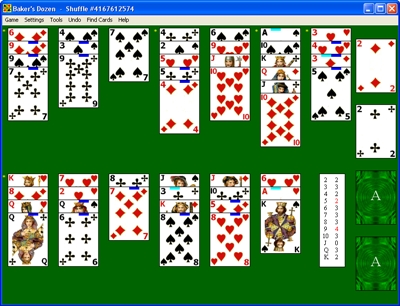
-
When playing Golf the game may be lost if certain cards on the wastepile are not built upon by the right card.
In the Golf screen shot below, all the queens are marked with orange strips. The orange strip means
that the number of cards or card sequences that can be used to place an orange card of a given rank
on the wastepile is equal to the number of orange cards of that given rank. If one more card or card sequence is
lost that can be used for building a card with an orange strip on the wastepile, the game is lost.
For example there are three queens in the tableau and one jack in the tableau and two jacks waiting
to be dealt. If one of these three jacks is used to move a ten to the wastepile and not a queen, the game is
lost. There will not be enough jacks to remove the three queens to the wastepile.
The player is notified whenever the game is lost and the card rank involved is indicated.
Otherwise the casual player could continue to play the game long after the game was lost.
-
When good locations for building are marked by an asterisk
Much of the time spent in playing La Belle Lucie is devoted to finding a place where building can be done without making needed cards inaccessible. If two cards of the same suit are in the same column and the rank of the bottom card is one rank above the rank of the top card, the top card cannot be moved unless it is sent to a foundation. Thus the top card is a good place for building and the bottom card of the column is marked with an askterisk in its upper right corner. If the bottom card is two ranks above the rank of the top card, the card of the same suit with the rank in between the ranks of the bottom and top cards cannot be moved unless it can be sent to a foundation. Thus the card with the in between rank is a good place for building cards. The bottom card of the column which has the two cards with a difference in rank of two is marked with an askterisk in its upper right corner. -
When foundation building progress is shown
Calculation has a complex pattern of building on its foundations. A table is given which keeps track of the building, allowing the player to play with better strategy. -
When the number of cards in the next redeal is known
If there are too few cards dealt for a given redeal, blocks in the layout that cannot be overcome will be more common when playing Intelligence. A table lists the number of cards that will be dealt for the next redeal. Ideally cards should continue to be sent to the foundations until this number hits zero. -
When the number of hidden cards for a given rank and suit are known
Often when playing solitaire it is helpful to know if a card of a given rank and suit has been uncovered especially when playing two deck game like Forty Thieves or Napoleon's Square. For example if all the two of clubs have already been placed in the wastepile, the player might as well place the three of clubs in the wastepile as well. All games with hidden cards have a table showing the number of cards hidden for a given rank or for a given rank and suit. These tables could be contructed by the player based on the ranks and suits of the faceup cards.